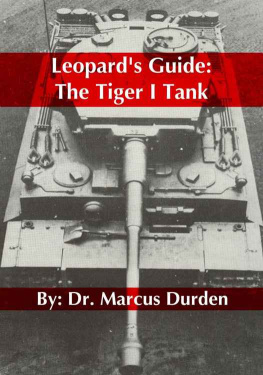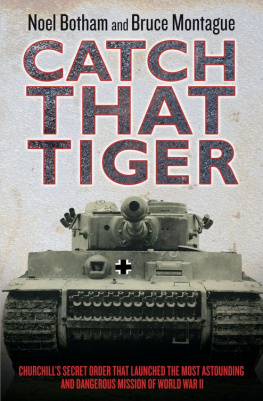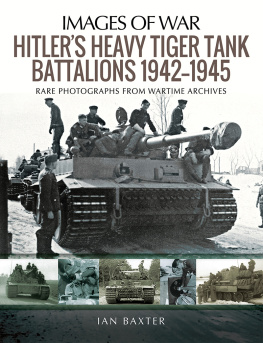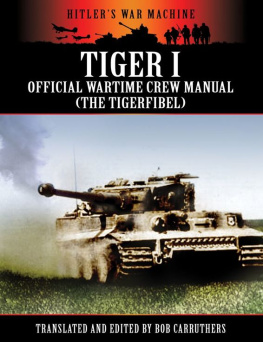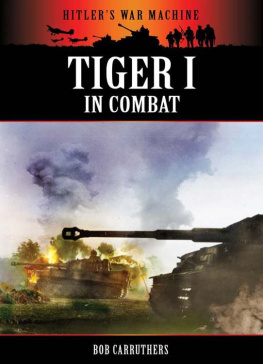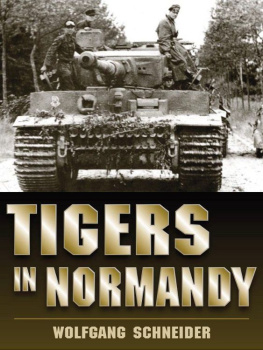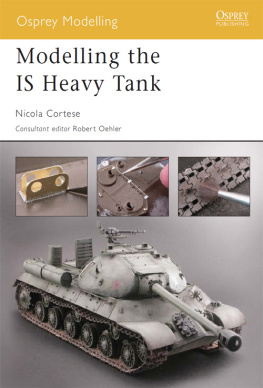Copyright 2013 by Dr. Marcus Durden
All rights reserved.
No part of this book may be reproduced in any form or by any electronic or mechanical means including information storage and retrieval systems, without permission in writing from the author. The only exception is by a reviewer, who may quote short excerpts in a review.
Preface
The Tiger tank was not just another tank; it was the end result of decades of tank doctrine development, manufacturing process refinement, and fortunately for the free world; a prime example of the deficiencies of the socialist economy as compared to capitalism.
This book sets out to document not just the Tiger I as a weapons platform, but the Tiger I as an expression of German tank doctrine and industrial base (as hobbled as it was by the dual anchors of Socialism and Hitlers madness). Though the Tiger was impressive in many ways, it was not the right weapon for a total war; unlike the Sherman (or to a lesser extent, the T-34 though it had severe flaws of its own that the Soviets hid by simply accepting huge losses). While the individual Sherman may have been inferior to the Tiger; they could be made by the dozen for each Tiger which is what you need when fighting a total war across the world.
So with that goal in mind; this book will chart the development of German tank doctrine from World War I till the end of World War II. The doctrines of other nations; particularly the Soviets, will also be touched upon to illustrate the differences between the opponents as they influenced each others doctrinal growth during the course of the war.
To a lesser extent, the German manufacturing process will also be examined to show how the Tiger I tank could have been a better weapons platform if it was simply made in a more efficient manner. While the process that the Germans used resulted in well made tanks, they simply could not be made in large enough numbers to change the outcome of the war.
Finally and perhaps most importantly, the Tiger I tank will be examined as weapons platform. Its effect on the strategic and tactical level will be examined over the course of the war with key case studies elaborated upon; such as the battle at Villers-Bocage or the numerous pockets that Tiger units were trapped in on the Eastern Front. A number of the more notable Tiger battalions and Tiger aces will also be illustrated to give more concrete examples of the capabilities of the Tiger.
Though no work can completely encompass all that went into the Tiger I tank; it is the hope that this book will touch upon the most important points and prove this authors point that the Tiger was the wrong weapon for World War II. Given Germanys position; investment in more air superiority fighters or even other ground platforms like the Panther or Stug III would have been much more efficient. Though at the most basic level, Germany would have been best served by not having an insane megalomanic in charge or going to war with the world...
1: Tiger I Stats
A Tiger I somewhere in Sicily, 1943, with replacement treads mounted on the glacis to bolster the armor (as well as serving as replacement treads); Useful against high tech armor piercing rounds deployed later in the war by the Allies (though even those had a hard time piercing the front glacis). The commander and the loader are standing out of their respective hatches, probably to help guide the large tank through narrow Italian streets. The barrel is shrouded to keep dust from clogging the breech of the 88 mm cannon; or from drifting further into the fighting compartment. Dust and mud were a constant threat to the Tigers mechanicals in every theater of the war as they only worsened the Tigers infamous unreliability in the field, though it was undeserved in some respects.
General Info
Official Name: Panzerkampfwagen Tiger Ausf. E
Unofficial Name: Tiger
Type of Vehicle: German Heavy Tank
Service Years: 1942-1945

A colorized photo of a Tiger I moving at full speed in France during the Allied Normandy Invasion. As the war progressed, Tigers would not risk being in an open field in the Western front during the daylight due to constant Allied air patrols. It was such a threat that the roof armor was upgraded in later Tiger models to counter the armor piercing shells used in Allied fighters automatic cannons (as well as the stupendous amount of heavy artillery fire that the Russians could rain down on the Eastern Front in addition to attacks from a fully rebuilt Red Air Force). This angle aptly shows the massive muzzle brake on the 88 mm Kwk cannon; necessary to control the recoil of the high velocity rounds. This photo also shows how extensive the camouflage paint was applied all over the Tiger to help conceal it. Camouflage paint was largely a German skill in the beginning of the war as other nations resorted to just color matching their hull paint to the surrounding environment without attempting to break-up the outline; though this differed greatly in the field with crews from all sides attaching foliage as ad-hoc camouflage.
Designer: Henschel and Sons (Porsche for limited run prototype hulls that were adapted into Tiger variants)
Manufacturer : Henschel and various subcontractors
Cost per Unit: 1,280,000 US Dollars ( in 2013 FY $)
Units Produced: 1347; including Porsche prototypes
Dimensions
Weight: 63 tons
Ground Pressure; Combat: 15 psi with combat tracks
Ground Pressure; Travel: 20 psi with travel tracks
Length with Barrel Backward: 20 ft 8.7 in (for transport)
Length with Barrel Forward: 27 ft 9 in
Width: 12 ft 2 (wider if crews attached bolt-on armor)
Track width: 2.36 ft with combat tracks
Height: 9 ft 10 in (not counting aerials)
Front and review view of the final Tiger I power-plant, the Maybach HL230 P45 V-12; a masterpiece of engineering even by modern standards. Though it could generate 700 horsepower at relatively low RPMs, it overheated easily and required powerful air cleaners to prolong its operational life. A victim of its own success, the Tiger was used as a tow vehicle because of its powerful engine, further straining the engine in the field and causing official orders forbidding the use of Tigers to tow anything least they breakdown... these were often ignored. Though the engine was maintenance intensive, it was coveted by the Allies and Soviets for reverse engineering.
Equipment
Armor : 120-25mm rolled homogeneous nickel-steel
Hull front: 100mm (3.94in) @ 24
Hull side (upper): 80mm (3.15in) @ 0
Hull side (lower): 60mm (2.36in) @ 0
Hull rear: 80mm (3.15in) @ 8
Hull top: 25mm (0.98in) @ 90
Hull bottom: 25mm (0.98in) @ 90
Turret front: 100mm (3.94in) @ 8

